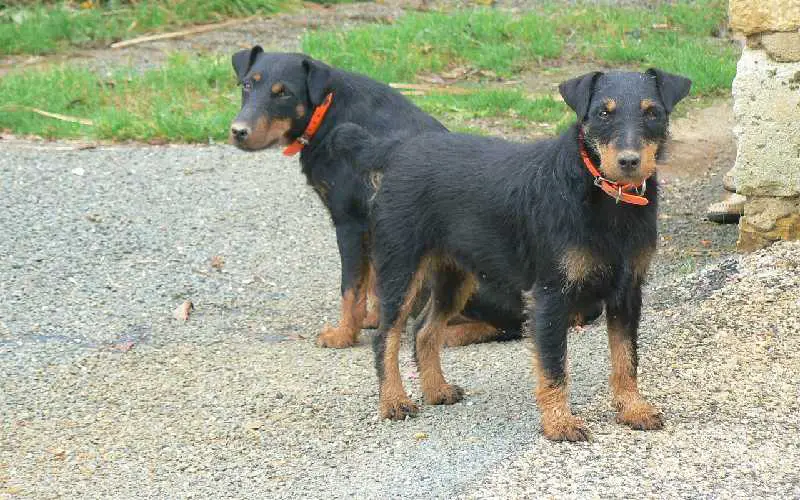The Jagd Terrier (German: “hunting terrier”) is a dog type developed from the German Pinscher and Deutscher Spitz, used as all-purpose hunting dogs once they were turned loose in large game coverts for hunting foxes or other quarry. They also served to drive game towards waiting hunters, as beagles do with rabbits. They were also used to hunt badgers in the early days of dog fighting and have many similarities to the Patterdale Terrier.
The History of the Jagd Terrier
Sigmund von Braunmühl was influential in developing this variety. Many etymologists maintain that the word “Jack Russell” is a corruption of “Jagd Terrier”. A terrier type known as the Pinscher, developed for working foxes underground, was crossed with the Deutscher Spitz. The resulting dogs (‘long-haired terrier’) were sold in England as White German Terriers, while the short haired version became known as Black and Tan Terriers. These distinctions eventually blurred leading to confusion about the true origin of today’s Jack Russells which may have been more influenced by terrier than spitz blood.
More recently, genetic analysis of the Jagd Terrier has determined that it is a cousin rather than descendant of either the Pinscher or the German Spitz. The Jagd Terrier shares a close ancestral relationship with the Fox Terrier and Border Terriers. These breeds share similar body shapes and are likely distant cousins of one another. The Jagd Terrier was bred for its hunting abilities whereas the Fox Terrier and Border Terrier were originally bred as vermin killers, though they have been used for fox and rabbit hunting in the past.
Jagd Terrier Appearance
The head is a modified wedge shape with a long muzzle that is deep at the root and tapers towards the nose. The skull is not flat but slightly arched with a distinct stop that is not too abrupt, but which blends into the forehead at an angle of 45 degrees. It should be as wide as it is long, tapering away from the eyes to meet the muzzle in a curve and widening again through the cheeks to lay flatly against the face. The topskull and muzzle should be of equal length, with a ratio of approximately 2:3.
The nose is black with well opened nostrils which are deeply set at the end of a narrow muzzle making it look somewhat triangular in shape, similar to that of the Bloodhound; although its ears are relatively large and soft, they do not reach the end of the nose. The jaws are powerful but should not be overshot or undershot. There is a complete set of evenly spaced, very strong teeth with scissor bite in which the upper teeth neatly overlap the lower ones.
The neck is strong and muscular, slightly arched towards the head. The topline should be level and the body compact.
The eyes are medium-sized, almond shaped and dark brown in colour. It is typical for this breed to have a lighter patch around the inside corner of each eye where the “haw” or scar tissue from the surgical removal of the embryonic light-sensitive membrane (tapetum lucidum) is located.
The ears are small, V-shaped and set fairly high on the head. They should be thickly covered with hair with long fringe, hanging below the jawline. In the old days they were cropped to make them stand upright but this practice is now illegal in many countries including The United Kingdom.
The tail tapers from the shoulders to a fine point. It is covered with hair and carried either in line of the back or curled over the back. Though it is traditionally docked, under American Kennel Club rules conformation dogs are not required to have docked tails as of 1991.. The coat should be short and flat lying. Colours include black and tan, liver and tan (a rich dark liver colour), white with brown or black markings.
Jagd Terrier Temperament
The breed has a high level of energy and can be challenging to train, but this also makes it very rewarding when a good relationship is established between owner and dog. Although the Jagd Terrier can compete in agility events, its high energy level means that it requires a very active owner with a large secure garden and plenty of walks. These dogs are often employed as search-and-rescue or therapy dogs because they are so friendly and sociable, but they also excel in sports such as flyball, agility, and competitive obedience trials.
If you enjoyed this article you might also like to read about Patterdale Terrier Jagd Terrier Cross


